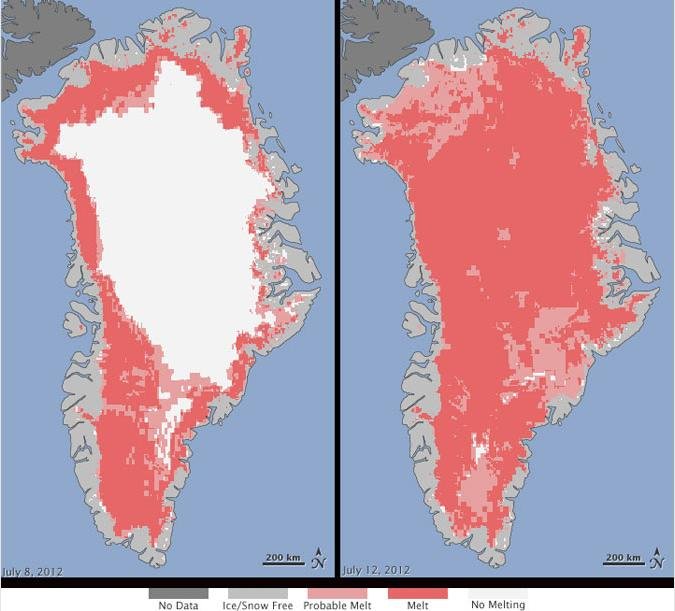Extent of surface melt over Greenland’s ice sheet on July 8 (left) and July 12 (right). Areas classified as "probable melt" (light pink) correspond to sites where at least one satellite detected surface melting. Areas classified as "melt" (dark pink) correspond to sites where two or three satellites detected surface melting. Credit: Nicolo E. DiGirolamo, SSAI/NASA GSFC, and Jesse Allen, NASA Earth Observatory
GREENBELT, Md., July 24 (UPI) -- For days this month, Greenland's surface ice cover melted over a larger area than at any time in more than 30 years of satellite observations, NASA says.
Measurements from three satellites showed that on July 8, about 40 percent of the ice sheet had undergone thawing at or near the surface, the space agency reported Tuesday.
Nearly the entire ice cover of Greenland, from its thin, low-lying coastal edges to its 2-mile-thick center, experienced some degree of melting at its surface, researchers said.
In most summers about half of the surface of Greenland's ice sheet naturally melts, but this year the extent of ice melting at or near the surface jumped dramatically, scientists said, with satellite data showing an estimated 97 percent of the ice sheet surface thawed at some point in mid-July.
"The Greenland ice sheet is a vast area with a varied history of change," Tom Wagner, NASA's cryosphere program manager in Washington, said.
"This event, combined with other natural but uncommon phenomena, such as the large calving event last week on Petermann Glacier, are part of a complex story," he said.
"Satellite observations are helping us understand how events like these may relate to one another as well as to the broader climate system."
Even the area around Summit Station in central Greenland, which at 2 miles above sea level is almost the highest point of the ice sheet, showed signs of melting, researchers said.
"Ice cores from Summit show that melting events of this type occur about once every 150 years on average," Lora Koenig, a Goddard glaciologist and a member of the research team analyzing the satellite data, said.
"With the last one happening in 1889, this event is right on time. But if we continue to observe melting events like this in upcoming years, it will be worrisome."















